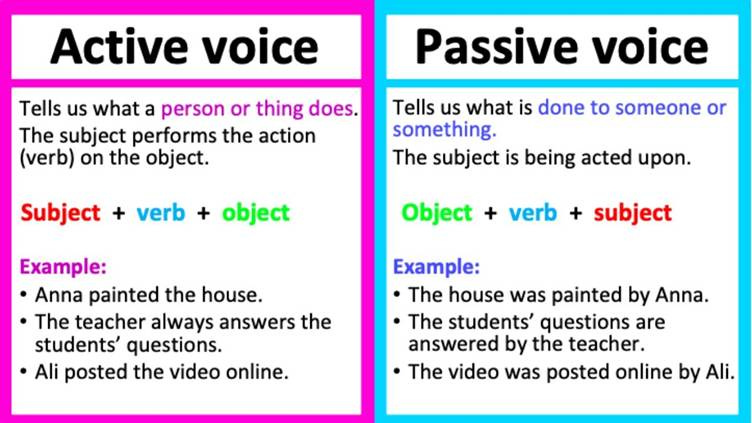Welcome to How to be a Teacher. Every week, I share the expertise of my colleagues and reveal what I’ve learned recently from their 70+ years of experience.
This week, the hottest debate of recent weeks in my team - what is the passive voice and how does it work?
I really, REALLY want your input on this.
Enjoy.
If this doesn’t make your ink boil, I don’t know what will.
This week, the planning meeting I had with my colleagues was fuelled by debate. It didn’t just get pulses racing – it wasted an almighty amount of our precious planning time as we mused the most complex of linguistic mechanisms: the passive voice.
And, for all my certainty the other day, I no longer know what is right and what isn’t.
I’d rather be certain that I was wrong. In fact, me being me, I’d rather be certain that I was right - but I’d take knowing I’m wrong over not knowing what’s what.
Do you understand the rules? Let’s see…
What is the passive voice?
It’s a bastard, is what it is.
Ok, I’m being dramatic. In practice, the passive voice isn’t difficult. It’s the antagonist of the more popular, more common active voice and the two are simply different ways to format a sentence. Here’s an example of how it works.
Active voice: the wind blew over the fence.
Passive voice: the fence was blown over by the wind.
Easy – the noun performing the action (in this case, wind) comes before the noun receiving the action (fence) in the active voice. In the passive voice, they swap places.
The idea is that whichever one you want to be the focus of the sentence comes first.
That’s all there is to it. Right?
Complication #1
They swap places – but you need to do more to it than that.
You couldn’t just turn ‘the wind blew over the fence’ into ‘the fence blew over the wind’. That makes no sense. Not in this world.
So you add a little extra in the middle to make sure the receiver is still the receiver of the verb/action:
Instead of ‘the fence blew over the wind’, you plum for, ‘The fence was blown over by the wind.’
There, that’s that sorted. Right?
Complication #2
In practice, this isn’t that difficult. Personally, I’d like to leave it there.
But one thing that our children are supposed to learn is what the subject and the object are in these sentences. When we’re working with the active voice, that’s ok – but it is still another rule to remember.
The subject is the performing noun (the wind) and the object is the receiving noun (fence). The verb (blew over) is in the middle.
Active voice: Subject followed by verb followed by object. Subject, verb, object. SVO.
In our team, we’ve come up with some novel ways to remember the order:
- Start Vacations Often
- Soft Vegetables Only
- See Venus Overhead
As long as it’s SVO, we think we can work with that. Children can remember that order.
So, in terms of structuring a sentence, that’s all the children need to know. Right?
Complication #3
This is the big one – and I need your help with it because it’s sparked some serious debate amongst our team and we’re no nearer the answer.
In fact, the more research I do, the less certain I am of what is right and what isn’t. That’s despite my conviction earlier this week: “I know I’m right.” Those were the very big-headed, egotistical words I used.
Let’s dig in…
Here is my understanding of the active-to-passive voice transition:
The subject is always the performer, meaning in the above sentence the subject is the wind in both the active and passive voices because it’s the one doing the blowing. The object is always the receiver – i.e. the fence, which is receiving the verb.
Why did I feel so certain this was the rule?
I was instructed this way at university during my Master’s
I wrote a research dissertation laced with the passive voice that scored 75%
I scored a Distinction overall in my course (the highest grade) – and my use of the correct tone and voice was regularly cited as a strength
So, I’ve cracked passive voice up to Master’s level.
I’ve since read about the passive voice online and found many sources that agree with me:
https://www.learngrammar.net/a/active-voice-vs-passive-voice-learn-the-different
https://grammarist.com/grammar/active-voice-passive-voice/
https://www.bbc.co.uk/bitesize/articles/znkvtrd
But, according to the writing scheme we use to teach writing in our school, switching from active passive voice actually works like this:
In the passive voice, the subject becomes the object and the object becomes the subject.
This isn’t the same thing as the method I am used to. According to this, the wind is the subject in the active voice and it becomes the object - yes, becomes the object - in the passive voice. The fence, therefore, goes from being the object to the subject.
Again, depending on where you look, you can find sources on the internet that support this interpretation:
https://www.bbc.co.uk/bitesize/guides/z2y9dmn/revision/5
On YouTube, Twinkl AND BBC Bitesize, I can find conflicting takes on the way subjects and objects change places in the passive voice. Yes, I can find both interpretations in the same place, and in multiple places.
I’ve even asked ChatGPT and it can’t makes its mind up either:
Attempt #1:
‘In the passive voice, the subject and object switch roles. Here's how it works:
In active voice, the sentence follows a structure where the subject performs the action, and the object receives it. For example:
Active voice: "The cat (subject) chased (verb) the mouse (object)."
In passive voice, the object of the active sentence becomes the subject of the passive sentence, and the original subject becomes the agent (often preceded by "by," though it's sometimes omitted if not necessary). The verb changes to a form of "to be" + the past participle. For example:
Passive voice: "The mouse (subject) was chased (verb) by the cat (agent)."
So, in passive voice:
The original object of the active sentence becomes the new subject.
The original subject becomes the agent (optional), often introduced by "by."‘
Attempt #2:
‘The rules regarding subject and object in the passive voice are generally consistent between UK and US English, but there can be some subtle differences in usage. Both varieties of English follow the same basic structure for transforming active sentences into passive ones:
In the active voice: Subject + verb + object
(e.g., The chef made a cake.)In the passive voice: Object + form of "be" + past participle + by + subject (optional)
(e.g., A cake was made by the chef.)’
The way ChatGPT works is it uses what’s on the internet already to form a composite answer to your questions. The fact it offers two different takes shows what is out there online – a general conflict of opinion.
In fact, when asked multiple times, ChatGPT preferred the method displayed in attempt #1 – the method that disagrees with the one I’m used to. Only when asked whether there was a difference between the way it is taught in the USA and the UK did it provide the second answer. Then, it wouldn’t stray from the second one, even when prompted to apply the first.
Adults don’t routinely understand the passive voice - it’s not common knowledge.
I didn’t use it until secondary school but even then it wasn’t explained properly. I only discovered the theory behind it in university, and only really mastered it in my PGCE year – my fourth year of higher education.
I’ve even tried explaining the whole thing to my degree-qualified partner while writing this article this morning, and she responded by rubbing her face in exasperation and saying, “I wish I’d never asked.” Genuine quote.
And the internet can’t even make its mind up on what the rule should be!
Which leads me to the real question here…
Why in God’s holy hat are we teaching this to 10-year-old children?
Why
oh why
oh why indeed?
Final note
This place is full of brilliant, talented educators with a penchant for the written word and academic qualifications coming out of their backside, so I figured this is possibly the best place to ask the following in my quest for understanding:
How do you explain the passive voice to your students?
And what is the correct was to apply the subject-verb-object nonsense? Do they swap places or do they change so one becomes the other?
Help!
Here’s more from me:
If you’ve enjoyed reading this (as well as my many other articles), I’ll bet you know someone else who would. Why not share this with them? Click below to get the link and send it their way.










For reference, I hate passive voice vs active voice too as in complex moments it does get confusing, but I think best way is to say that "An active subject does, a passive subject recieves." Maybe put a name tag on a kid that says "Subject" and then have two cards, which look exactly the same, but on one it says "Passive" and one says "Active", then place a sweet on their desk. They choose a card at random (passive or active is hidden from view) if its active, the sentence would be "[Student's name] gives a sweet to Mr. Jack." And they have to give it back to you but if they choose passive the sentence would read, "[Student's name was given a sweet by Mr. Jack." Its a bit mean, but could be funny, you could also do it so that they all get the sweet but either write "NAME was given a sweet by Mr Jack." Or "Mr Jack gave NAME a sweet." For passive and active respectively.
Dunno, what do you think?
I think the most important sentence in this column is your question, why are we teaching this to 10 year olds?